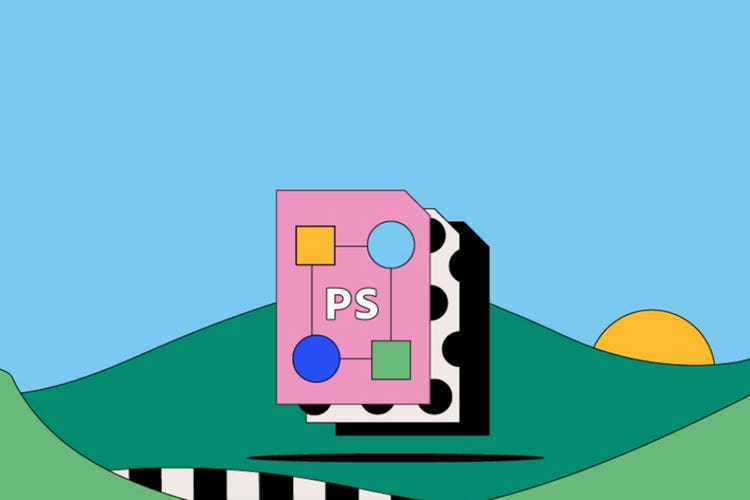Format PS
Les fichiers PS tiennent leur nom du langage de programmation PostScript. Ils ont été les premiers à établir une connexion entre les ordinateurs et les imprimantes. Le langage PostScript a permis de traduire les mises en page numériques en impressions combinant texte et images. Découvrez les origines, les cas d'usage et les avantages des fichiers PS.

Qu'est-ce qu'un fichier PS?
PS est l'abréviation de PostScript, un type de fichier image vectoriel. Les images et les textes numériques contenus dans un fichier PS présentent l'avantage d'être prêts pour l'impression. Vous pouvez envoyer un fichier PS directement vers une imprimante sans avoir à l'ouvrir dans une application. Cependant, c'est aussi le type de fichier image le moins polyvalent, car peu d'applications peuvent l'ouvrir.
Les fichiers PS étant un peu plus anciens que certains types de fichiers associés, ils sont plus faciles à manipuler une fois convertis en PDF.
Histoire des fichiers PS
Adobe a développé le fichier PS dans les années 1980 pour permettre aux utilisateurs d'ordinateurs de transformer facilement leurs textes et leurs images en impressions. Ce fut une étape importante pour le secteur naissant de la PAO. La prise en charge du format PostScript sur les premières imprimantes Apple a marqué le début de l'essor mondial de la PAO. Les journalistes, les étudiants et les amateurs pouvaient enfin transformer leurs manuscrits en publications visuellement attrayantes.
Maintenant que la publication directe sur le Web a remplacé l'impression (sauf pour les publications spécialisées), le format de fichier PS n'est plus aussi populaire qu'auparavant. Il reste néanmoins l'un des plus intuitifs.
Utilisation des fichiers PS
Le fichier PS est l'un des types de fichiers image les plus anciens encore disponibles. Voici quelques exemples de son utilisation actuellement :
Impression efficace
PS est idéal lorsque vous avez besoin d'imprimer un fichier. Que vous imprimiez chez vous ou que vous envoyiez le fichier pour impression à distance, une fois le document enregistré, vous avez l'assurance d'obtenir une impression fidèle à votre création.
Mise à l'échelle des images pour l'impression
Vous pouvez mettre à l'échelle les images d'un fichier PS sans perte de qualité, quelle que soit la résolution choisie. Le format PS est donc tout indiqué pour obtenir à coup sûr une impression de qualité professionnelle.
Avantages et inconvénients des fichiers PS
Avant de commencer à travailler sur votre prochain projet, prenez connaissance des avantages et des inconvénients des fichiers PS.
Avantages des fichiers PS
- Les fichiers PostScript peuvent être utilisés sur n'importe quel appareil. Donc, que vous imprimiez sur une imprimante professionnelle ou personnelle, vous obtiendrez toujours une qualité égale.
- De plus, la qualité est excellente. Les fichiers PS produisent des détails plus précis et plus nets que n'importe quel autre langage de description de page.
- Les fichiers PS éliminent le problème de compatibilité entre Mac et PC. Vous pouvez utiliser ce format sur les deux systèmes d'exploitation.
Autres caractéristiques notables des fichiers PS
- Les fichiers PS produisent des résultats de qualité, mais ne sont pas aussi rapides que d'autres types de fichiers similaires.
- La plupart des logiciels actuels ne prennent plus en charge le type de fichier PS, mais quelques passionnés continuent de l'utiliser.
- Bien que le format PostScript soit bien pris en charge par les imprimantes, tous les modèles ne sont pas en mesure de convertir efficacement ces fichiers.
Ouverture d'un fichier PS
Outre les applications Adobe comme Illustrator et Acrobat, vous pouvez utiliser d'autres logiciels pour ouvrir correctement un fichier PS. Double-cliquez simplement sur le fichier à ouvrir et choisissez votre programme parmi les options proposées par votre ordinateur.
En modifiant l'extension, vous pouvez aussi ouvrir un fichier PS dans un navigateur Web, notamment PostScript Viewer and Compiler pour Chrome.
Création et modification d'un fichier PS
Utilisez Adobe InDesign pour créer un fichier PostScript pris en charge sur tous les appareils. Voici comment :
- Sélectionnez Fichier > Imprimer.
- Dans la boîte de dialogue d'impression, sous Imprimante, sélectionnez Fichier PostScript.
- Définissez l'option PPD sur Indépendant du périphérique.
- Affichez ou modifiez les paramètres d'impression existants.
- Cliquez sur Enregistrer.
- Choisissez un emplacement, saisissez un nom et recliquez sur Enregistrer.
Poursuivez votre lecture sur la création de fichiers PS dans InDesign.
Format PS : foire aux questions (FAQ)
Quelle est la différence entre un fichier PostScript et un fichier PDF?
Le PDF est-il un fichier PostScript?
Toutes les imprimantes utilisent-elles le format PostScript?
Comment vérifier si mon imprimante utilise PostScript?
Qui a inventé le format PostScript?

Découvrez comment les fichiers d'illustration Adobe Illustrator gèrent les images vectorielles.

Découvrez la capacité des fichiers SVG (Scalable Vector Graphics) à conserver la qualité d'image.


